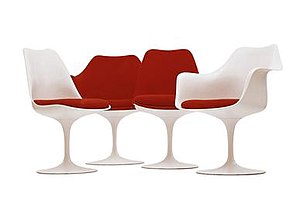|
Tulip chair
The Tulip chair was designed by Eero Saarinen in 1955 and 1956[1] for the Knoll company of New York City.[2] The designs were initially entitled the 'Pedestal Group' before Saarinen and Knoll settled on the more organic sounding 'Tulip chair' to mirror its inspiration from nature.[3] It was designed primarily as a chair to match the complementary dining table. The chair has the smooth lines of modernism and was experimental with materials for its time. The chair is considered a classic example of industrial design. The chair is often considered "Space Age" for its futuristic use of curves and artificial materials. Design and constructionSaarinen said: "The undercarriage of chairs and tables in a typical interior makes an ugly, confusing, unrestful world. I wanted to clear up the slum of legs. I wanted to make the chair all one thing again."[4] Saarinen had hoped to produce the chair as a one piece unit made entirely of fiberglass, but this material was not able to support the base, and prototypes were prone to breakage. As a result, the base of the tulip chair is of cast aluminum with a rilsan-coated finish to match the upper shell, giving the appearance of a single unit. The upper shell is molded fiberglass, with a reinforced, plastic bonded finish.[1] The upholstered foam cushion is removable with Velcro fastening.[2] Saarinen was awarded a patent for the Tulip chair in 1960.[5] Awards
Project CybersynIn 1971 a modified form of the Tulip chair was used in the design of Project Cybersyn.[6] See alsoReferences
|
||||||||||||||||
